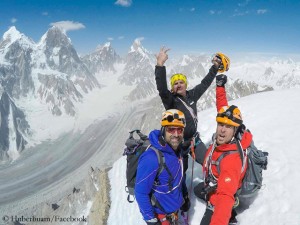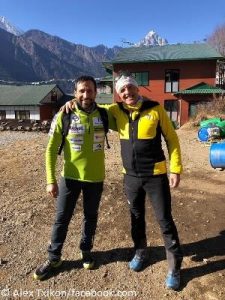Alexander Huber: “Ogre is not a man-eater”
Ogre has on the Huber brothers almost the same effect as the singing of the Sirens in Greek mythology: the two German top climbers can hardly escape the call of this fascinating granite giant. Time and again in their long careers Alexander and Thomas Huber have set off to the Ogre massif in the Karakoram or the nearby peaks of the Latok group. In 1999, they failed in their attempt to climb the 7,285-meter-high Ogre I. Thomas succeeded the second ascent of the mountain in 2001, along with the two Swiss Urs Stoecker and Iwan Wolf. The first ascent was made almost 40 years ago, on 13 July 1977 by the British climbers Chris Bonington and Doug Scott. The descent became a drama with a happy end: Scott broke both ankles, Bonington two ribs. Nevertheless, both of them, supported by the other team members, reached the base camp one week after their summit success – one of the great survival stories on the highest mountains in the world.
Easier doing it with friends
Yesterday Alexander Huber set off to Ogre. His team includes the two East Tyroleans Mario Walder and Christian Zenz and the Swiss Dani Arnold. With Dani (and Thomas Senf), Alexander had opened a new route through the Matterhorn North Face last March. With Mario and Christian, he had succeeded the first ascent of a route on the mountain Ritterknecht in East Greenland in summer 2016. “It’s good to be on the road with partners you know,” says Alexander Huber. His three companions are not only good, competent climbers, but also friends, says the younger of the two Huber brothers. “You have to spend a lot of time together, often moments of tension. The better the human chemistry fits, the better it is.” I talked with the 48-year-old about his expedition before he left for Pakistan.
Alexander, you are heading to Ogre, a seven-thousander in the Karakoram. What exactly are you planning?
We would like to climb the East Pillar. This route has not yet been completed. (Several attempts on the east side of Ogre failed, e.g. in 1992, a Spanish team turned around in a snowstorm at 6,500 meters.) But it is not so much the idea to create a first ascent on this mountain, but to reach the summit at all. It is one of the most exclusive peaks of our planet, one of the most difficult spots to reach. Thomas realized the second ascent of Ogre in 2001, since then there was only one further ascent (in 2012 by the Americans Kyle Dempster and Hayden Kennedy). That shows, this is not an easy summit, but that’s exactly why we want to go there.
Only three ascents – and there was no lack of attempts, there were well above 20 expeditions on this mountain. What makes it so difficult?
The Ogre is simply an incredibly complex mountain with many objective dangers, arising from the seracs, which are practically on all sides. That’s why the East Pillar is our goal – because, from my point of view, it is free from objective dangers. Seen from a distance, I believe we can avoid all the seracs on this route. We will see what happens in reality. But I hope that we can explore and realize the maximum safe way to the summit of Ogre.
Ogre means “man-eater”. Does this mountain justify its name?
Actually you cannot really say that. There was an accident in which a climber was killed. (On a German expedition, which tried in 1993 to climb via the Ogre South Pillar, the Swiss Philipp Groebke fell to death.) However, it’s certainly not the man-eater in itself. For this, the mountain is too challenging. Meaning that all of those who try to climb Ogre are competent, strong climbers who know exactly what they are doing. Usually mountaineering becomes dangerous when incompetent people try to reach a summit. The best example of this in the Himalayas is surely Mount Everest. There will be a lot of fatalities in the future too because many people want to climb the mountain without having the necessary skills. In this respect, Ogre doesn’t deserve its name. It’s not a man-eater.
However, Ogre is not its original name, but Baintha Brakk. Baintha is a meadow on the edge of the Biafo Glacier, from where the highest point of the mountain can be seen as the dominant peak. Brakk means peak. So it is the peak that you can see from the meadow Baintha. In any case, I think we should return to the original names of the mountains. Mount McKinley is Denali, Mount Everest from the Tibetan side Chomolungma, from the Nepalese side Sagarmatha, K 2 is Chogori, and Ogre is Baintha Brakk.
The past summers in the Karakoram were very warm. This led to the failure of many expeditions. What kind of weather will give you a real chance on Ogre?
If we have the same conditions as two years ago (then the Huber brothers were en route with Mario Walder and Dani Arnold in the Latok group), when the zero-degree line was at 6,500 meters and higher over several weeks, we will get into trouble again. I think mountaineering will change in the future due to climate change anyway. The mountaineers have to adjust to this. If the zero-degree line continues to move up, we will have to switch to the fall or spring season. I have now chosen the summer season again, because I am convinced that on the way to the summit of Ogre it is important that you do not have low temperatures in the summit area. Perhaps we are lucky that this time the conditions fit. The weather is difficult to interpret. But these are the challenges we are now confronted with.
You have already canceled an expedition to Pakistan in 2014 because of the explosive political situation. Do you go there again with a queasy feeling?
Unfortunately, you cannot travel in Pakistan like you did 20 years ago. I have been able to get to know Pakistan at a time when the division did not exist between the Western world and the Muslim, Arab world. At that time you could move freely in this country. If you are traveling across the countryside today, you can never be sure that there will not be any terrorist attacks, especially against tourists. That’s why there is no more tourism in Pakistan. The people who still travel to the country are exclusively mountaineers who have a very specific goal. When we go there, we are really undercover on the road, which means we are not visible.











